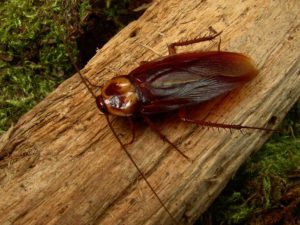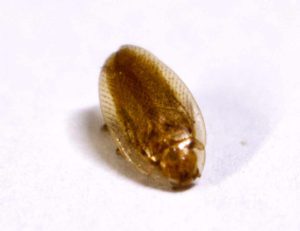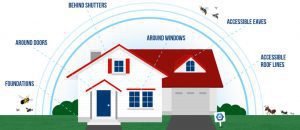WHEN OUTDOOR COCKROACHES MOVE INSIDE
By Chris Williams on August 26, 2019.
Many of you are aware that there are indoor cockroaches that can take over your kitchen and make your life miserable. Did you know that there are even bigger outdoor cockroaches as well? In fact, they may be living around your home’s foundation at this very minute, just waiting for an opportunity to move inside.
PERIDOMESTIC COCKROACHES CAN LIVE IN OR OUT
It’s the German cockroach that most of us know, some only too well. This small, tan and black roach is our truly “domestic” cockroach that lives with us inside with no outside connection. In fact, the German cockroach could not survive winters outdoors, nor does it want to try. It is totally adapted to life with people and can reproduce indoors year round.
On the other hand, “peridomestic” cockroaches are at home both in your home and outside. These are cockroaches that are capable of living and reproducing both outdoors and indoors. In southern states, they can spend almost all of their time outside because winter temperatures are tolerable. In our Northeastern region, outdoor cockroaches survive freezing winters only if they move into buildings, or into sewers or similar sites, or they hunker down in protected places outside and become relatively inactive.
OUTDOOR COCKROACHES FOUND IN OUR REGION
Consider yourself lucky if you live in New Hampshire or Massachusetts because we have only two or three outdoor cockroaches to deal with: the American cockroach, the Oriental cockroach, and on occasion, the woods cockroach. In warmer and more humid southern and coastal states, they have several different species of cockroaches that live outside and will occasionally move inside, and even reproduce inside.
(1) American cockroach (Periplaneta americana) – This is our largest cockroach at about 1-1/2 inches long. It can run quickly and climb walls. It’s a reddish-brown color with pale yellowish margins around the thorax. It has long wings that cover its abdomen and allow it to glide from a high place. The American cockroach nymphs, the stage more likely to move inside, are shiny, reddish-brown, and wingless.

American Cockroach (Periplaneta americana). Shutterstock
The American cockroach is found outside in mulch, rotting leaf litter, decaying logs, woodpiles, stumps, ground cover plantings, around garbage, and in similar sites. In our area of the country, though, American cockroaches are more likely to be found in less visible outdoor sites that remain warmer in winter such as sewer systems, steam tunnels, and dumps that generate their own heat deep within.
American cockroaches have a slow lifecycle with only one generation a year and little overlap of stages, at least outdoors. For example, all of the nymphs hatch out at approximately the same time in June. In fall, the population is at its largest and the bulk of the population is large cockroach nymphs. These nymphs, along with the few remaining adults, are all competing for food and will soon be competing for protected winter sites (see American Cockroaches Can Migrate Into Buildings).
(2) Oriental cockroach (Blatta orientalis) – This is the only one of our outdoor invading cockroaches that cannot fly. Unlike the American cockroach, the Oriental moves slowly and cannot climb vertical surfaces. It’s a large roach at about 1-1/4 inch, but not as large as the American cockroach. Adults are shiny dark brown to black, while nymphs are more red-brown and look much like American cockroach nymphs. The male has short wings, less than 2/3 of the length of his back, but he can’t fly. The female Oriental cockroach has nonfunctional wing buds and the nymphs are wingless. Like the American cockroach, the Oriental only has one generation a year.
The Oriental cockroach is found outside in dark, damp undisturbed sites, similar to the American cockroach. Around foundations, it can be found under mulch, under planters, near garbage cans, compost piles, in window wells, under stones or in rock walls, and similar sites. See Oriental Cockroaches Can Migrate Indoors in Fall.
(3) Woods cockroach (Parcoblatta pennsylvanica) – This seasonal invader is smaller, at about 1 inch, and more slender than the American or Oriental cockroaches. The male is light brown to chestnut brown with long wings, while the female is smaller, dark, and virtually wingless. The reddish-brown nymphs look much like Oriental or American cockroach nymphs.

Pennsylvania wood roach. Z. Ciras
If you have lots of trees on or next to your property, you may be familiar with woods cockroaches that are found in rotting wood debris where they feed on decaying matter. Around homes, they can be found in gutters, potted plants, under wood siding, or in firewood.
Woods cockroaches are not common indoors in fall and winter but sometimes accidentally get inside during their mating season in early summer (June). The males fly to lights at night and are strongly attracted to sex pheromones given off by the female cockroaches (see Early Summer Means Wood Cockroaches Are Active). Because the woods cockroaches don’t survive long or reproduce when they find themselves indoors, they can’t be considered a true peridomestic species.
WHAT DO WE MEAN BY SEASONAL INVASIONS?
Say it’s fall and imagine you’re an outdoor cockroach. Your winter options are to (a) burrow down under a log and forget about eating until spring, or (b) live in the sewer system where “food” is abundant, or (c) move into a building where you can be relatively cozy and people leave food for you. Where are you going to spend your winter?
Not all cockroaches have the three choices above. Woods cockroaches will pick only option (a) because living in the woods is the only thing they know. They would eventually die inside a building even in the best cockroach conditions. Despite that, immature wood cockroach nymphs do sometimes spend some time inside when they are accidentally carried in on firewood.
Once days get shorter and nights get cooler in fall, outdoor cockroaches become less active, feed less, and begin to move into protected sites where they can spend the winter. But not all cockroach invasions are escapes from cold or even weather-related. Other changes can also prompt outdoor cockroaches to seek better conditions elsewhere: if their environment becomes too hot, too dry, too wet, or too crowded, or not enough food is available (the latter is usually not a problem for cockroaches with their varied diet).
The woods cockroaches are seasonal invaders, too, but not for the same reasons or at the same time of year. They can be accidental indoor invaders during their early summer mating season. During that time, the male wood roaches, especially, travel about more and are apt to get into homes and other buildings.
INVASIONS FROM SEWERS, LANDFILLS, AND DUMPS
In the United States, American cockroaches have the distinction of being the most common cockroaches found in municipal sewer systems and storm drains. Oriental cockroaches can be found in sewers, too. The below-ground warmth and available food in sewers allows roaches to survive the winter. Sewer cockroaches can invade homes or retail businesses directly through sewer pipes and dry floor drains, or during sewer line breaks or backups (see Yes, There Are Cockroaches in Your Sewer System!).
Garbage dumps and debris landfills are two other outdoor sites where peridomestic cockroaches on rare occasions build up to very large numbers. These cockroaches (Americans in our region) spend the winter deep inside layers in the dump enjoying the heat generated by decomposition. But, if those comfy conditions change, large numbers of roaches can flee the dump and invade nearby buildings.
HOW DO COCKROACHES GET INSIDE?
Since the American and Oriental cockroaches often live in debris around the foundation of buildings, it’s easy for them to find openings around pipes, utility conduits, foundation vents, cracks in mortar, and brick weep holes that will let them inside. It’s even easier to enter through gaps around basement and garage doors, window wells, or lower level windows.
Woods cockroaches usually don’t plan to move inside. They are attracted to bright outside lights. As a result, woods cockroaches end up on porches, decks, and garages, near doors and windows where they can wander in through gaps or openings. Like the other cockroaches, they can also be carried indoors in firewood or flowerpots. One of the best ways to keep woods cockroaches out is to manage your outside lighting (see Porch Lights Attracting Bugs? Choose a Better Bulb).
WHERE DO THESE OUTDOOR COCKROACHES GO ONCE INSIDE?
Cockroaches can dry out if they don’t have enough humidity in their lives. When outdoor cockroaches move indoors, whether or not they can survive and then reproduce depends in large part on whether moisture levels are high enough. You are most likely to find them near water sources on lower levels of buildings, where it’s damp and dark. In homes, basement laundry rooms fit the bill.
Although they usually enter buildings at the ground level and remain there initially, once established, invading peridomestic cockroaches can move to other floors.
American and Oriental cockroaches are scavengers feeding on a variety of items: people food, decaying materials, garbage, dead insects, pet food and pet poop, etc., and can find something to eat most anywhere.
American cockroaches invade commercial buildings more often than homes and they can usually be found on the lowest floors in warm, dark, damp areas such as boiler rooms, vending or break rooms, garbage or compactor rooms, garages, utility tunnels, crawlspaces, or near steam pipes, floor drains, or water heaters.
Oriental cockroaches can be found indoors in lower levels of buildings. They prefer damp basements, cellars, crawlspaces, and other low level cool, dark, damp areas. They can be found near floor drains, leaky water pipes, under washing machines, in trash rooms, and in water meter vaults.
Woods cockroaches aren’t happy about being inside and can rarely find a place that meets their needs. They usually die fairly soon. Males may be seen for a short period at night near lights; females usually remain hidden but you might find them in dark, damp corners or under items on ground or lower levels.
WHAT CAN YOU DO ABOUT OUTDOOR COCKROACHES NOW?
The most important first step is to find and eliminate, or treat, the places where outdoor cockroaches are living. Move firewood, stacks of stones, and debris piles away from the foundation, reduce heavy mulch or piles of leaves, clean roof gutters and correct moisture issues, both inside and outside (see Control Oriental Cockroaches Outside First).
Then, take steps to block roaches from getting inside through openings or gaps. Pay special attention to doors, especially garage doors. Add weather strips to sides and thresholds or sweeps around door bottoms. Repair and tighten screens. Caulk openings around conduits, pipes, and other entry points.
But don’t delay. For American cockroaches, for example, you want to have outdoor controls in place in August or soon thereafter since cockroaches will be attempting to move inside from August until November. Outdoor baiting for cockroaches can be successful in late summer while the nymphs are still feeding. Outdoor cockroach fall migrations are the perfect situation in which to take advantage of Colonial Pest’s Preventative Maintenance Program.
Our technicians apply a semi-annual perimeter treatment around the foundation and other cockroach entry points into your home. One of the best things about this preventive service is that you don’t even have to be home, it’s all done outside. And you can leave it up to us to schedule it at the best time to prevent fall cockroach invasions.
WHAT CAN YOU DO ABOUT OUTDOOR COCKROACHES ONCE THEY’RE INSIDE?
Answer: give Colonial Pest a call. In fact, if you’re one of our Preventative Maintenance Program customers, we will take care of any invaders free of charge.
Treating indoors for peridomestic cockroaches is a bit different than treating for the German cockroach or other domestic cockroaches that hide in cracks and crevices. The American cockroach often climbs walls and hides in plain sight near the ceiling, and the Oriental can be found in dark, damp corners. But leave it to Colonial’s pros to find them and take care of the problem.
We can also advise you on pest exclusion — steps that you can take both outdoors and indoors that will keep outdoor cockroaches and other pests away. Remember, once peridomestic cockroaches find their way inside and like what they see, they can set up housekeeping and may breed there!